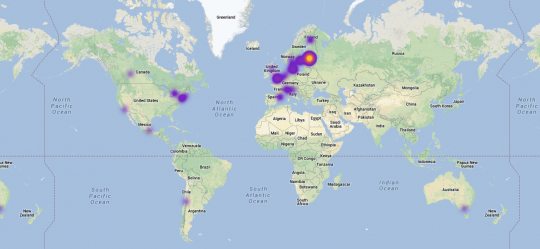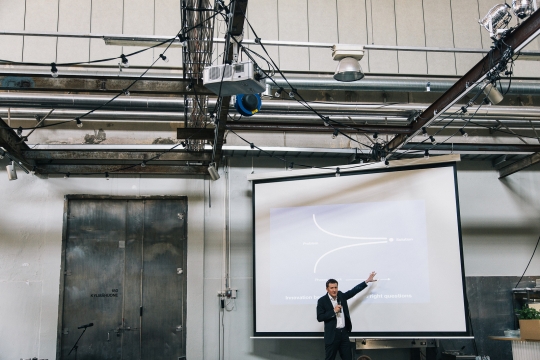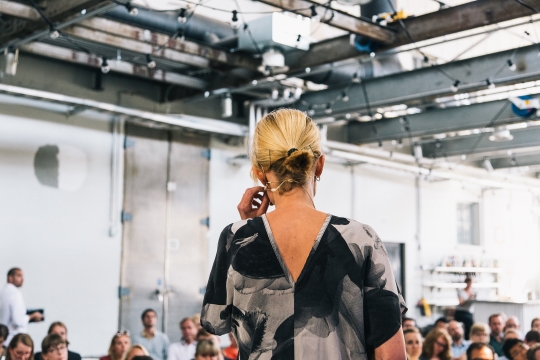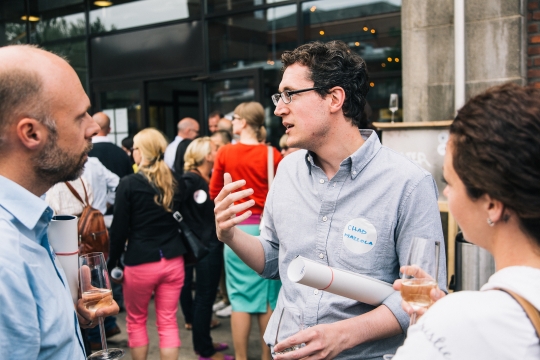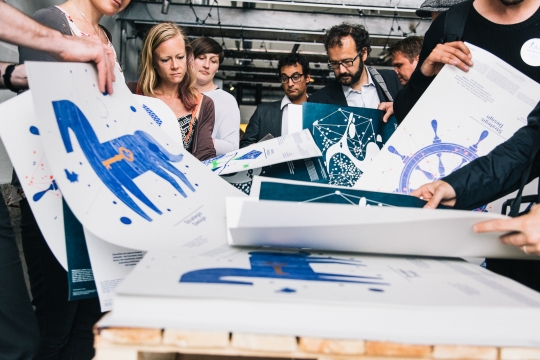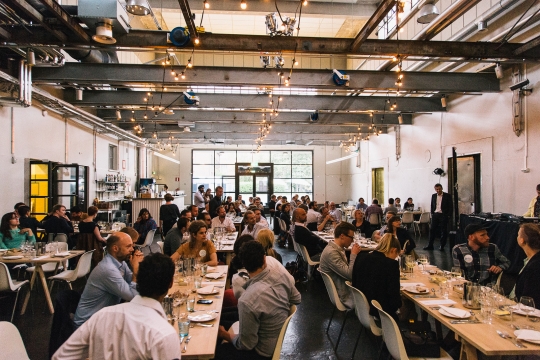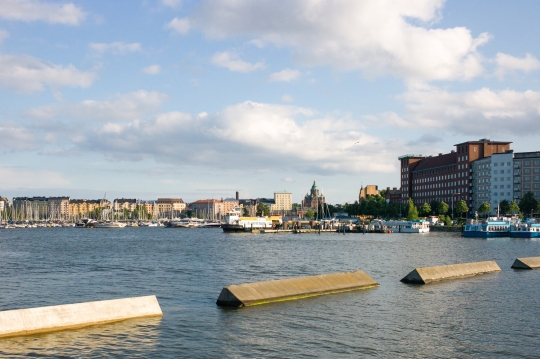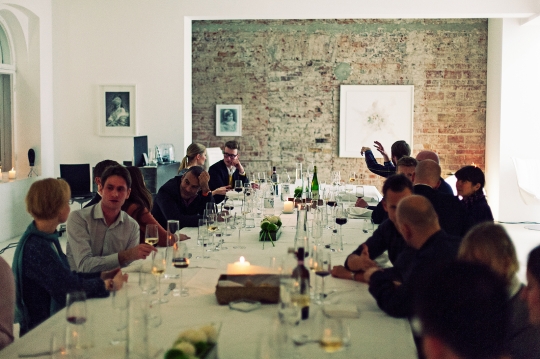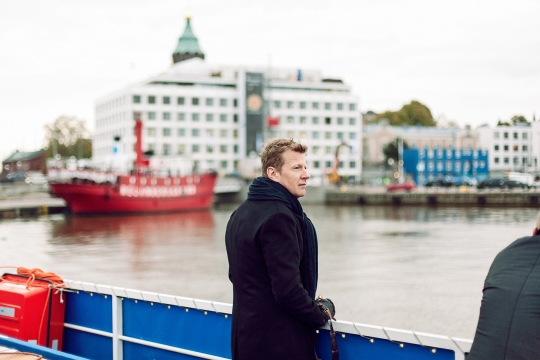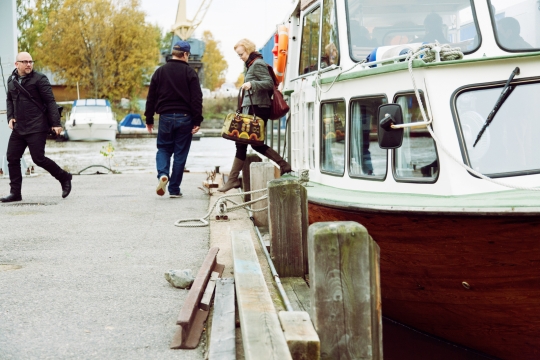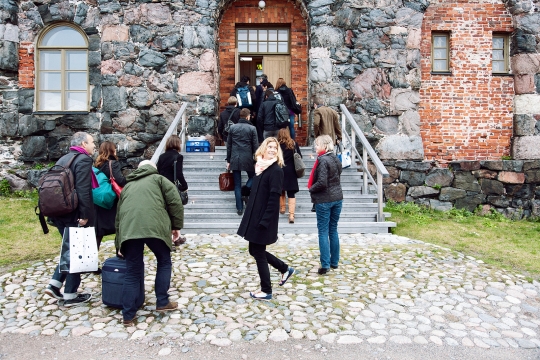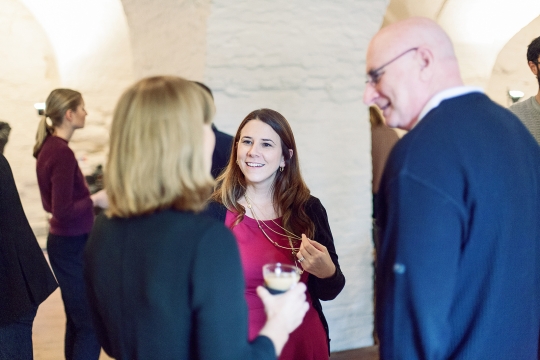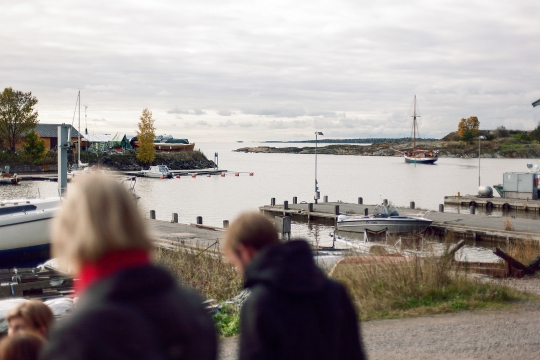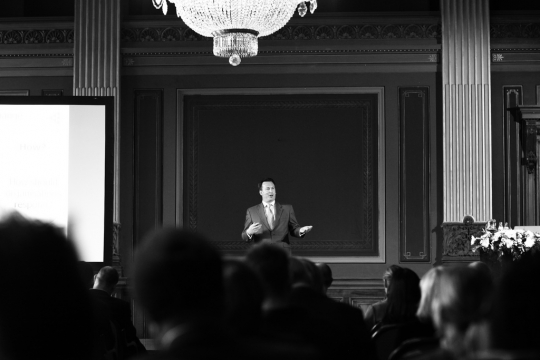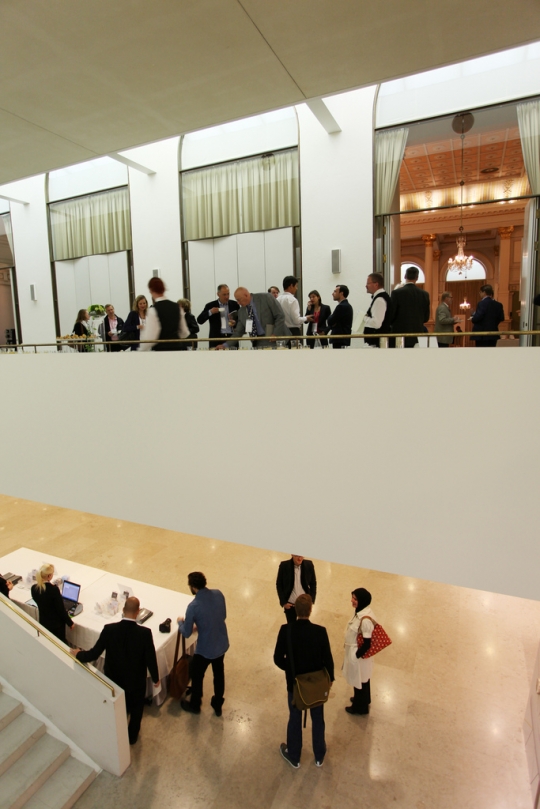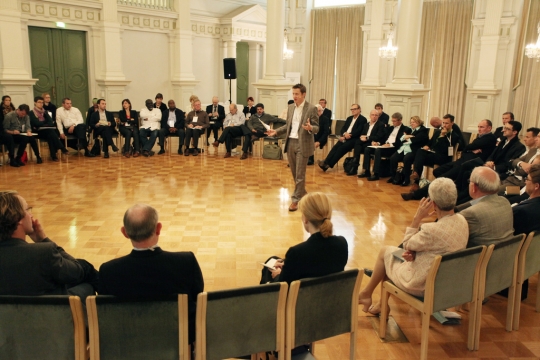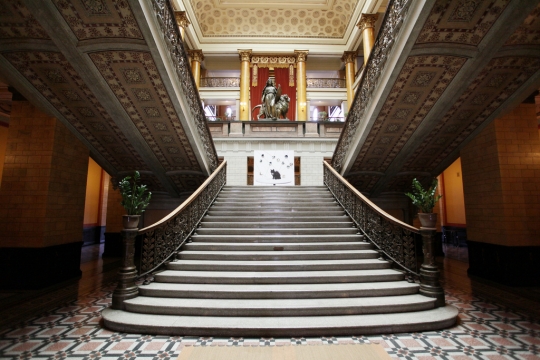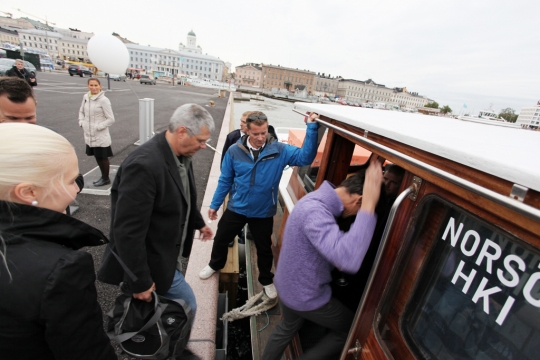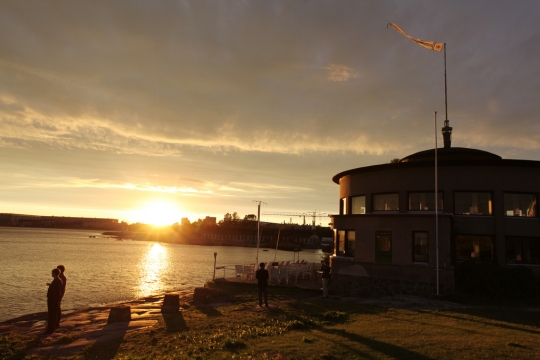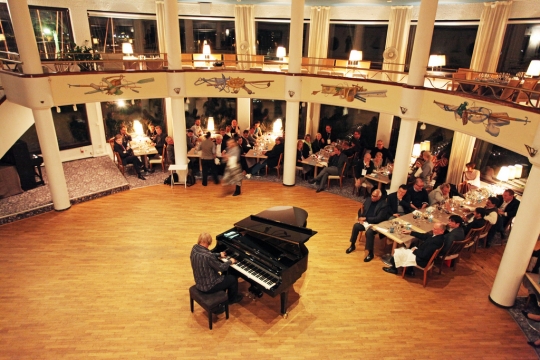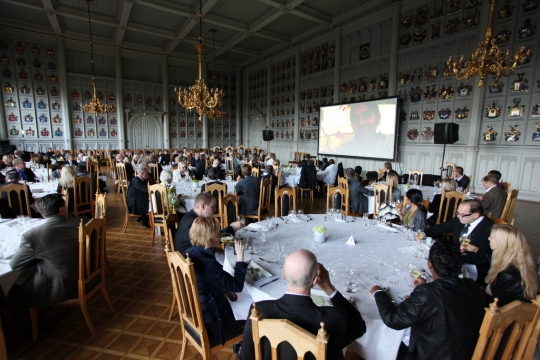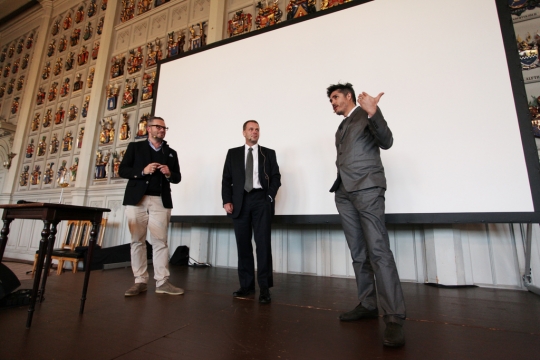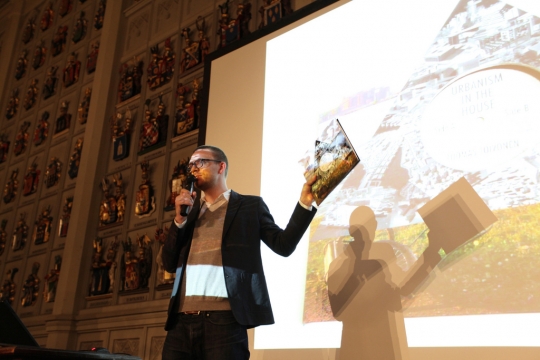HDL Global
As we're putting the finishing touches on the HDL living archive (what this site will shortly become) here are some images from our closing event, HDL Global 2013.
We were joined by 116 people from five continents. With talks from a mix of newscomers and old friends alike, it was an excellent way to pass the torch—to you!

This and other images below by Johannes Romppanen
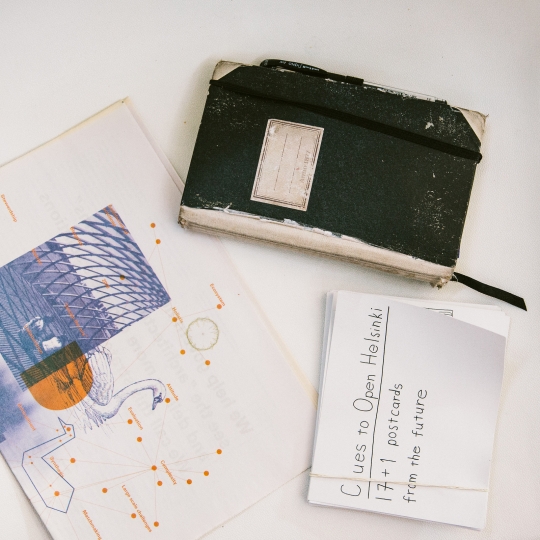
One in a series of chair portraits taken by Johannes.
There are many more photos on our Flickr page.
HDL Speaker Timo Arnall also has a collection of great photos from the event.
We have about 200 people joining us for HDL 2013 next Monday and a good portion of them are coming from outside Finland. In case you're not familiar with the city, here are some suggestions for things to do when you're not at the event.
Meals
nb. Restaurants in Helsinki can have idiosyncratic hours and often book up quickly. It's best to check online before you visit, or even give them a ring.
Atelje Finne
14 Arkadiankatu
Modern Finnish cuisine in what used to be a sculptor's studio.
Kolme Kruunua
Liisankatu 5
A little slice of Finland circa 1950. Try the meatballs or the salmon soup.
Dong Bei Hu
Korkeavuorenkatu 47
It sounds odd to have Chinese food in Finland, but this is some of the best to be found outside of the Middle Kingdom.
Glass of wine
Latva
Korkeavuorenkatu 25
Occupying a quiet corner in one of Helsinki's leafier neighborhoods.
Open late
Putte's
Kalevankatu 6
Pizza and drinks with grad students and cool kids.
Coffee or a small breakfast
SIS Deli
Kalevankatu 4
Coffee, tea, and snacks in a crisp space.
Fratello Torrefazione
Yliopistonkatu 6 (inside the Kluuvi mall)
Good coffee & good people-watching on a busy downtown street.
Good Life
Kolmas Linja 17
Part of Finland's new wave of coffeeshops.
See a bit of Helsinki
Kulttuurisauna
Hakaniemenranta 17
Relax in Helsinki's newest (and best) wood-fired public sauna. Like none other.
Ateneum
Kaivokatu 2
Go for the paintings by Finnish masters Akseli Gallen-Kallela and Hugo Simberg.
Suomenlinna
Pohjoisesplanadi 39
Have a walk around this island fort just off the cost. Public transport takes you there and back from Kauppatori, the market square.
Bring home something nice
Design Forum
Erottajankatu 7
Selling a wide variety of products by local designers.
Artek
Eteläesplanadi 18
More than sofas, but those are nice too.
Iittala
Pohjoisesplanadi 25
Glassware and other things for the home since 1881.
To supplement what Dan wrote about the proceedings of HDL Global 2012, I wanted to share some of the photos from the event as well. Thanks to Johannes Romppanen for all of these!
And more on Flickr.
We're now working on the cases from HDL 2012 to get them into a format that can be shared more widely. No promises on the timeline for that, but perhaps early-mid next year.
Editor's note: We offered this blog as a platform to four HDL Global participants who are documenting the event for everyone to get a glimpse of how things went down. This is one such post by Rory Hyde.
The further into Helsinki Design Lab Global I went, it became increasingly clear that there would be no easy takeaways. This was not your typical conference where a group of specialists come together, read out papers, and gently propel a subject forward. The theme 'Government Meets Design' brought together two groups of people that rarely cross over, and now that the dust has settled, it's clear to me that this mixing was the most important contribution.

Dinner at the House of Nobility
To enable this mixing to occur, the HDL team at Sitra produced an excellently orchestrated series of presentations and discussions over the three days. It's of course impossible to do any of the speakers justice in a blog post, but as I and my fellow documenters were tasked as the 'eyes and ears' of this invite-only event, to expose the thinking and ideas beyond the 120 participants, I'm going to try to be comprehensive.
Needless to say, these reflections come from my own particular perspective as an architect; an architect trying to come to terms with what being a 'strategic designer' means. What kinds of skills might we need to cultivate in order to play the role of designer within an organization or government? And how might organizations or governments be more cooperative with designers?
To get at these questions, I will focus on concrete examples of projects discussed throughout the presentations. I hope you enjoy this express trip through HDL 2010.
Day 1
The introductory event takes place in the appropriately named 'House of Nobility'. We are seated in a huge timber-lined volume, surrounded by all manner of elaborately carved coats of arms.
After entrees and a brief introduction by Marco Steinberg there is a screening of the short documentary film 'Tending the Garden City' directed by US architect Helen Han. It examines the waste problem in Bangalore, where municipal collection cannot keep up with demand, recycling is uncommon, and separation of waste is left to an underclass living on huge dumps outside the city. With a deceptively simple and affordable recycling container developed by Daily Dump, led by Poonam Bir Kasturi, this excess of waste is turned into a localised source of value. Daily Dump is a fantastic example of the power of strategic design, and explored in depth by the HDL team in this case study.
Part design research, part investigative journalism, Han shows the use of film as a critical tool for the strategic designer. It can build a narrative around research and also get directly to the human face of the problem and solution, giving shape to a conversation.
Next up is an informal chat between Alejandro Aravena, principal of Chilean architectural practice Elemental, and Helsinki Minister for Housing Jan Vapaavuori, moderated by Monocle magazine's Tyler Brûlé. Aravena's social housing work in Chile is an almost archetypal strategic design project, and is also written up in detail by the HDL team. Mixing systems thinking, rigorous research, political imperative and economic constraints, Aravena's 'half of a good house' approach cuts across policy, social need, and the role the designer can play in interfacing between the two.

Tyler Brûlé, Jan Vapaavuori and Alejandro Aravena in conversation.
More interesting, regarding the overall theme 'Government Meets Design', is Aravena's practice model. Elemental was co-founded by Andrés Iacobelli, who holds a degree in public policy, and is now Secretary for Housing in Chile. Simply by the implicit skills and roles of its founders, Elemental is a bridge between design and government; a relationship that has placed the practice in a central role in the reconstruction efforts following the Chilean earthquake in February this year.
For desert, local architect Tuomas Toivonen of NOW served up a potted history of social housing in Europe, from Ebenezer Howard's Garden City, Le Corbusier's Ville Radieuse, to the crumbling dystopia of Paris' Banlieus. If all this sounds pretty dry, I should mention it was delivered in a rap. Yes, rap. With this, Tuomas held up his end of the bargain as a 'designer' - the crazier, and more creative side of the design meets government split.
'U = Utopia' film clip by Tuomas Toivonen
Day 2 - Morning
Day two begins in the equally elaborate House of the Estates. Top marks to Sitra for moving us around the city to different venues instead of locking us in a fluoro-lit conference centre. Lined with chunky granite cobblestones, Helsinki is a great city to walk around, an experience made all the more pleasant by carefully positioned HDL people holding giant white balloons and offering directions.
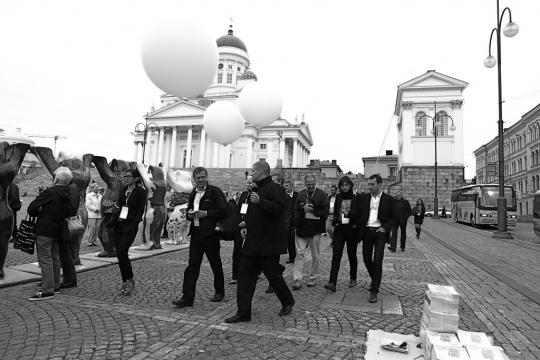
HDL guides with white balloon helping guests move between venues
I've discussed one anecdote of Marco Steinberg's introduction in an earlier post The Bus Schedule, Not the Building, which tries to get at this concept of 'strategic design', a topic elaborated upon in Marco's introduction letter, which is now also online.
Marco also presented the Stroke Pathways Project, a research project from his time at Harvard, described as 'applying strategic design to systems of care.' Through design tasks such as mapping, Marco and his team revealed some shocking realities about access to stroke care in the US. Despite the millions spent on facilities, due to the time-critical nature of stroke, only a tiny portion of the population would ever make it to these centres due to their geographic distribution.
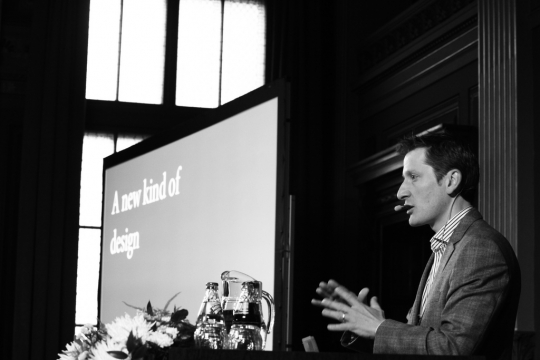
Introduction to Day 2 by Marco Steinberg
By examining stroke at the meta scale, and reframing it as an issue of access, not just health, the Stroke Pathways Project provided decision makers with a more complete picture of the challenge faced, and enabled them to make more informed steps to address the issue. This is another fantastically clear case study that shows the strength and necessity of strategic design as an emerging way of thinking and practicing.
In another presentation that looked beyond assumed answers, Dr LaSalle Lefall, chairman of the President's Cancer Panel in the US, discussed his role as announcing roadblocks to the treatment and prevention of cancer. Efforts included the prevention of arsenic in chicken feed and the use of growth hormone in livestock; big picture challenges that have huge implications for the safety of the entire food system. Dr Lefall balanced this meta-view of the problem with an emotional plea to consider first and foremost the 'patient as the object of our affection', stating that this empathy is 'the hallmark of the medical profession' and perhaps other professions as well. A sobering reminder of what is really relevant.
Business consultant Darrel Rhea followed up with a tour of innovation in 20 minutes. Rhea's presentation highlighted the importance of leadership support in driving innovation, and that although radical thinkers are critical, if positioned in the wrong part of an organization, efforts to initiate change will face stiff resistance. In a nutshell, "social dynamics are more important [to innovation] than technical ones."
Nick Mabey, CEO of E3G, offered one of the most instrumental bridges between 'government' and 'design'. As a former senior advisor to the UK Prime Minister's Strategy Unit, Mabey is well versed in the politics of decision making. His presentation titled 'Why muddling through wont do,' highlighted the need for shepherding a proposal through the elaborate institutional hoops of policy, regulation and permissions.
Coming from my own experience as an architect, this seemed like a constructive alternative to complaining, something architects seem so fond of doing. Instead of complaining about the council, the planners or the residents when a scheme gets stuck, Mabey suggests we instead learn to play the politics; to carefully navigate our proposals through these systems to achieve the desired result. Perhaps this process could even be viewed as part of the design problem itself.
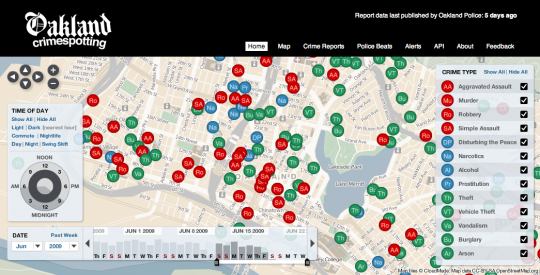
Stamen's Crimespotting: an interactive map of crimes in Oakland, California
To round out the morning, Eric Rodenbeck discussed the role of visualisation through examples of his work at Stamen. In particular, the Crimespotting project captures most explicitly the important role of design in interfacing public data. By mapping reported incidents of crimes over a map from a period of time, this isolated data forms a valuable resource for policy makers, business owners and residents alike. The visualization is presented as "an object to think with, to talk about the world as it actually is."
But this open source future isn't all happy families. Eric casually mentions that much of the data they used had been 'scraped' from municipal websites. This exposes the not always comfortable relationship between government and design. Stamen were not commissioned to do this work, but are driven by their own interests and values, as they explain on the project page: "we believe civic data should be exposed to the public in a more open way." This shows an active or provocative role design can play in leading a conversation about the ways public information should be treated.
Day 2 - Afternoon
In the afternoon of day 2, we split into 3 groups for panel discussions on the topics of Ageing, Sustainability and Education. These themes were determined by the HDL Studios run earlier in the year.
I went along to the ageing session, mainly as it's something I know little about, but am fascinated by as it seems to be one of those issues that thoroughly transgress boundaries, comprising healthcare, accessibility, education and policy to name a few. But as the panel members of this session quickly pointed out, to even describe ageing as an 'issue' is to misrepresent it. Jane Barratt, Secretary General of the International Federation on Ageing, stated 'We're still talking about ageing as a problem, and yet we're all doing it.' To which James Peake added 'It's a process, not a problem'.
To someone not familiar with this topic, I have to admit that at first this sounded like semantics. But of course, how a topic is framed has such an influential bearing on how it is responded to. As long as ageing is perceived as a problem specifically concerning the health issues of advancing age, not about the larger issues such as the city and the systems that serve it, ageing will continue to be dealt with from this limited perspective. As John Beard of the World Health Organization Department of Ageing stated, 'A good city for the elderly, is a good city for everyone.'
The other big issue surrounding ageing is the pension age. As I'm writing this, a grey Frenchman is sporting the cover of the IHT protesting against Sarkozy's proposed change of the retirement age from 60 to 62. The panel treated this issue as not about a number, but about providing flexible working arrangements. Perhaps designers could again take the lead here, as many architects famously worked until they practically dropped dead over their drafting boards. Oscar Niemeyer continues to work in his office in Rio at the impressive age of 103! But maybe that's not everyone's cup of tea...
The final session of a packed day 2 was Rosanne Haggerty's presentation of Common Ground, the project she established in 1990 in New York City to tackle the issue of homelessness.
Through deep research—effectively getting to know every homeless person in the Times Square area by name—Common Ground arrived at a new level of understanding of the issue, and were able to uncover the hidden reality of homelessness, that the vast majority of homeless are only homeless for one night or two. Long-term homeless, people living on the street for a year or more, were the ones at real risk, and became their target group in an effort to tackle the root of the problem.
By reframing homelessness as a public health issue, Common Ground has been able to mobilize decision makers across systems to unlock new funding streams. The program has been an incredible success, having housed over 3000 individuals, and leading to a drop of homelessness in the Times Square area of 87%. The Common Ground model is now being scaled up across the US and beyond.
Day 3
Another day, another venue. This time we make ourselves at home in the Helsinki City Hall, a 19th century neo-classical building with a slick Aarno Ruusuvuori interior dating from the late 1960s. We also faced a new spatial arrangement—in the round—which suited the discussion format well, and seemed to encourage more participation from those not 'officially' on the panels.
First up was the forum titled A Changing World, moderated by Alan Webber, co-founder of Fast Company magazine and all-round nice guy. Alan opened with the deceptively simple question "what are we wasting our time talking about?" This prompted a discussion about 'control' and our excessive need for it, a point illustrated by the comment "we are trying to be 1945, we should be in 1870, when the world last exploded." Are we living through another industrial revolution, a period of intense change and upheaval? Indeed, as another comment made clear, "we should be incredibly optimistic, everything we have thought about 30 years ago has come to pass."
The other dominant theme is that of the network, and the responsibility we have in ensuring that networks offer benefits instead of act as a source of problems. As another comment showed, our current networks are socially fragile: "a bunch of traders discovered an opportunity in the network we created and exploited it to its breaking point." Leading to the critical question, "how can we inject values into the network?" I like this idea, that this giant machine may become more gentlemanly, embracing a code of ethics or responsibility. Surely there is a need for a designer here.
Ok, we're almost there! The final session is led appropriately by Marco, our indefatigable guide to the past 3 days. Titled Redesigning Leadership, again the conversation hovers in a space of constructive speculation. The 'leader' (of a company, a government, an institution) is recast as not an enforcer of control, but as an enabler, "unlocking individual desire." This leads to the role of 'risk' and 'failure' in successful leadership, something which may depend on the context leaders operate within. Indeed, the inability of leaders to acknowledge failure may stand as a barrier to a constructive debate. With its rapid production and discarding of ideas and prototypes, perhaps the design profession can offer a model here?
This atmosphere is summed up best by Ezekiel Emmanuel's elegant phrase "combative collegiality," used to describe a healthy debate that can propel an idea, but where the adversaries don't take personal offence to contrary views.
It reminds me of a description of the ideal undergraduate design studio as "one with low partitions." High enough that you can get on with your own work, but low enough that you can peek at your neighbour's work, spurring constructive competition. It would seem to me that this is an attitude missing in politics at the moment (perhaps with the exception of the UK's 'Question Time'), particularly given the dearth of vision or ideas in the recent election campaign in Australia, my home country. If we're redesigning leadership, designers and their methods could have a lot to offer.
Conclusion
If you've made it this far, you're no doubt hoping for something profound. Unfortunately, as I hinted at the beginning, there would be no such thing. Taken together, the presentations at HDL Global offered a number of fascinating case studies and individuals that embody the aims of 'strategic design' or occupy the ambiguous territory of where 'government meets design'.
And like any conference, the 'real' work happens in-between, over coffee, at dinner, or on a boat ride. I'm sure I can confidently speak on behalf of the 120 other participants to say that it was an incredible privilege to have been brought together and to be exposed to their minds and ways of thinking.
There are no 10 steps, no rules, only a group of people who I hope will push this 'strategic design' approach through their own work so that it may gain momentum and legitimacy, ushering in a new group of thinkers able to bridge between the disparate worlds of 'government' and 'design'.
To paraphrase the punchline of the 70s sci-fi film Soylent Green, the takeaway is people!
All photos in this post by Ivo Corda.
Editor's note: We offered this blog as a platform to four HDL Global participants who are documenting the event for everyone to get a glimpse of how things went down. This is one such post from Anna-Leena Vasamo, who writes to us from Pune, India where she is currently working.
A couple of weeks after HDL Global, the themes presented at the event are resurfacing on the other side of the world. In India, recent encounters with design professionals have turned out to be reminders of the unique event and have provided a chance to reflect on the ideas of HDL.
A recent discussion with the founder of an established Indian design company revealed that it was the possibility to integrate ideas from fields such as psychology, art, science and philosophy that drew a specialized engineer into the field of design. The role of the designer, as was aptly described by Rory Hyde in his guest blog post as the integrator or “professional generalist”, seems to be an allure that draws experts from a variety of fields to design. Interest in the bigger picture and the desire to understand challenges in a holistic manner looks like a common denominator in the global design community.
With HDL Global fresh in my mind, interacting with a new generation of designers in India has also allowed me to identify some great homegrown, grassroots-level experiments with strategic design. An attempt by two talented local designers to understand and visualize the challenges of sustainable urban development in the Indian context is an example of such activity.
These experiences reinforce the excitement and interest toward the progress of Helsinki Design Lab. The idea of Finland as a global platform for systemic innovation is intriguing: I hope Finland will provide a model that the rest of the world can follow.
Editor's note: We offered this blog as a platform to four HDL Global participants who are documenting the event for everyone to get a glimpse of how things went down. This is one such post by Ido Mor.
I recently finished reading The Soul of a Chef by New York Times writer Michael Ruhlman. Apart from inspiring me to try some new things in the kitchen, it got me to reflect back on our three memorable days at the HDL Global at the beginning of this month. In his book, Ruhlman gains access to interview and shadow several of the most influential chefs of American cuisine. He’s out to uncover what makes these people so great at what they do, exploring the source of their passions and intensely focused drive. Interesting overlaps surfaced – a couple of which I’d like to share here.
Begin with the right foundation and strive to make it perfect. In culinary terms this means that great dishes are not a result of how much foie gras, truffle oil, or other fancy ingredients we throw into our recipes. Truly memorable dishes trace back to the very beginning of their creation, applying the most basic of cooking techniques to produce a solid foundation.
A clean veal stock is a base ingredient in many classical French sauces. If you start with a mediocre veal stock it makes no difference if everything that follows is perfectly executed and plated. The best you’ll achieve is still a mediocre dish.
This is reminiscent of our discussions of the architecture of the problem. It illustrates the importance of taking the time to reframe our questions correctly. If we fail to do this, our best attempts at problem-solving will remain mediocre at best. Ruhlman specifically uses the word, “strive” (to make it perfect), in order to acknowledge that we’ll never reach perfection. The moment we think we’ve attained it, there’s still more that can be done. Nonetheless, this level of ambition is critical.
Have a purpose for everything you do. Chef Thomas Keller of the renowned French Laundry in Yountville, California (Napa region), points out that successful cooks who began in his kitchen succeeded because they treated it as their own. He creates an environment that honors the importance of food. It would be illogical to think that a cook can be less than fully invested when cooking with Keller, and somehow flip a switch and develop that care and respect for perfection later on in life. In setting the tone, Keller sets expectations. It’s clear to him early on who has the right attitude and who doesn’t.
As leaders in our various arenas, if we’re not investing ourselves in the success of our desired outcomes, we’re ultimately just executing a process. That alone will not yield great results. We must tap into the purpose of why we do what we do, infect our colleagues with that same passion, creating the environment for them to give of themselves as well.
Where do we go from here?
Looking back at the discussions that took place in Helsinki, the value of applying a systemic approach to problem-solving became increasingly apparent. We also realized that for some us in the room, the tendency to think in terms of systems comes more naturally—and still we struggle to affect change on the scale we’d like to see. This raises several key challenges:
How do we build awareness of the values and methodology of a systemic approach to problem solving in our varying organizations (some of which tend to be more progressively oriented, and some less so)?
How do we build the multi-disciplinary teams needed, considering that existing organizational divisions likely inhibit us from reaching our desired outcomes?
We often lack the structure by which to guide a collaborative approach to systemic problem-solving. What toolkits or frameworks will help our diverse organizations navigate such ambitious change? How can we make it easier to implement new methodologies with far-reaching implications?
Feel free to share your thoughts and experiences below.
After getting to know each other over dinner and then diving in to learn about strategic design with a series of lectures and panel discussion, the third and final day of HDL Global 2010 kicked off at Kaupungintalo, Helsinki's City Hall.
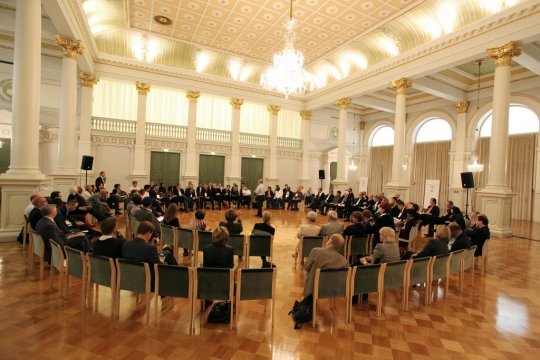
Why are "roundtables" so often square? Day 3 was held in a big circle to encourage a naturally inclusive conversation.
The building itself is a fascinating symbol of redesign. On the outside and in the banquet hall at the center of the building it's a grand 19th century palace. But everything in between was renovated at the height of Modernism in the late 1960s, creating a nice contract between the sleek lines of the new and the ornate decoration of the old.
Friday was simple: two closed-door panel conversations with time and space to chat.
Alan Webber, founder of Fast Company magazine, moderated the opening panel on A Changing World.
Marco moderated a session on the changing nature of leadership.
And we left plenty of time in between for people to meet and chat.
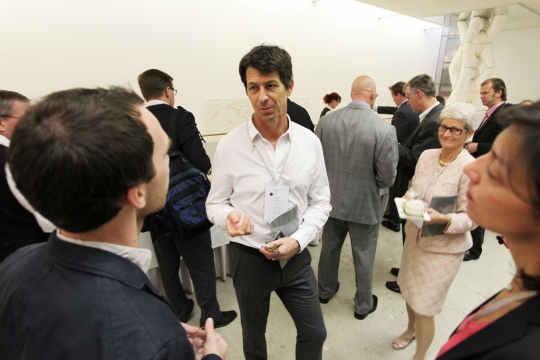
John Beard of the World Health Organization chatting with Ido Mor of Cheskin Value Added and Maja Kecman of the Helen Hamlyn Centre.
Day Two was packed. Up early after a great opening night, we started at 09:00 in Säätytalo, Finland's House of Estates (also known as the former meeting place of Parliament). A more grand setting could scarcely be found in Helsinki and we're very grateful for the opportunity to share the experience of being there with all of the HDL Global participants.
Marco began the morning by making the case for strategic design, telling a story about a swimming pool and a bus schedule, and playing a short animation.
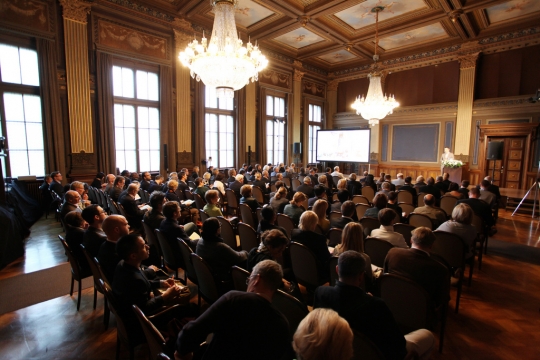
Marco giving the first talk of the morning.
LaSalle Leffall was next, sharing his experiences on the President's Cancer Panel and their recent focus on environmental, systemic factors that contribute to cancer. To hear from such a well respected practitioner in the medical realm asking for more big picture thinking was a call to action that underscored the urgency of the conversation throughout the rest of the event. Whether in medicine, education, climate change, welfare, or other topics, stepping back to see the big picture is essential if we want to truly deliver real value.
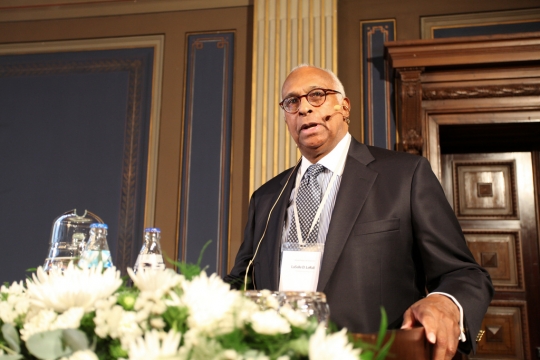
LaSalle impressed everyone with a perfectly delivered oration.
Next up was a series of three brief presentations. These were conceived as "brain dumps" which would help establish a shared terminology.
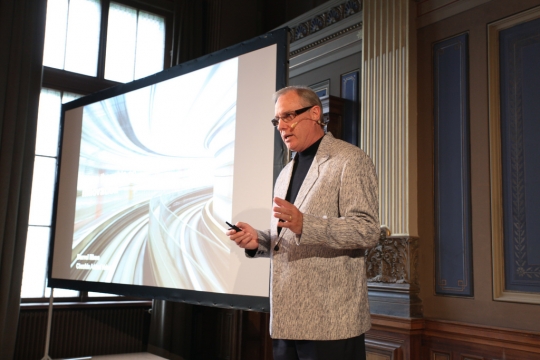
Darrel Rhea, CEO of Cheskin Added Value, spoke on innovation, with a focus on the different between incremental and disruptive innovations and how those models demand different approaches.
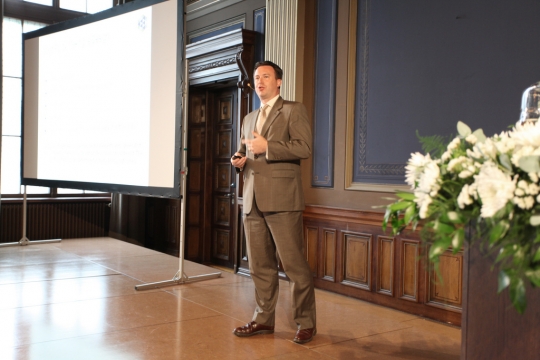
Nick Mabey, CEO of E3G, shared his thoughts and deep experience with the realities of decision making in the political arena.
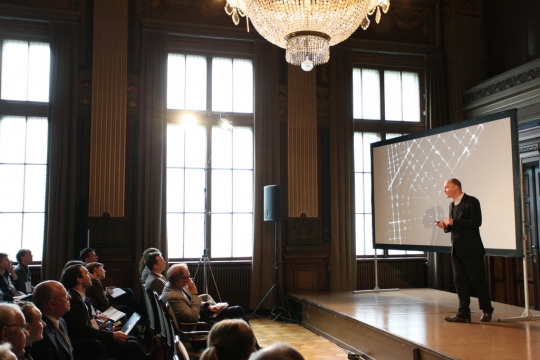
Eric Rodenbeck, Creative Director of Stamen Design, shared his group's work on using visualization to ask new questions, beyond merely documenting known facts.
To give everyone a chance to see more of the city, and to add a bit of refreshment, we took a walk for lunch at local restaurants instead of having it catered in.
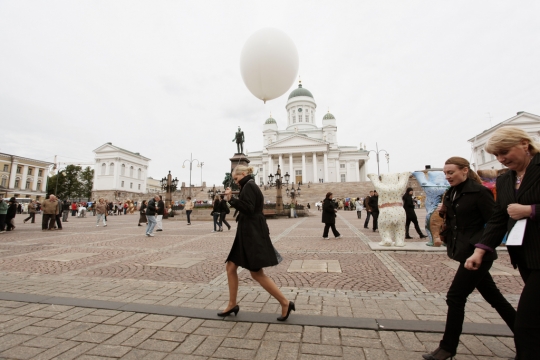
Follow the big white balloons!
Returning from lunch, we split up into three concurrent panel discussions focusing on the HDL Studio topics from earlier in the summer. Each of these closed door open and honest discussions used the HDL Studios as a starting point and opened the conversation to our global group of participants. These sessions started with short videos such as this one from Education and a similar video from the Sustainability session.

Dan Hill moderates the Sustainability panel discussion with Oras Tynkkynen, an MP in Finland; Tuuli Kaskinen of Demos Helsinki; and Peter Sharratt of WSP.
At the close of the day we gathered together for a final presentation, this time from Rosanne Haggerty who shared her work at Common Ground. Rosanne continued the theme of housing which was brought up in the conversation between Minister Vapavaauori and Alejandro Aravena the previous evening, but her focus on homelessness and Common Ground's work to "eradicate homelessness" provided a different—and inspiring—view of systemic redesign in action.

Rosanne Haggerty closing the second day of HDL Global 2010.

Is there a better meeting space in Helsinki?
To honor Tenley Albright's long career fostering collaboration across many different communities, we loaded everyone on to boats for a cruise through the harbor and dinner at the Boathouse.
After-dinner conversation included a spirited debate about what was a more spectacular end to the day: an incredible sunset or Iiro Rantala's performance in celebration of Tenley. You decide:
One note of business: all panel discussions were closed-door and will remain private, but in the coming months we will be posting videos of the talks by Marco, LaSalle, Darrel, Nick, Eric, and Rosanne. In the mean time, if you just can't wait to see more there are tons of pictures on Flickr.
HDL Global 2010 was designed as a social gathering, so what better way to emphasize this than to start with a dinner? The first day of the event started at 18:00 in the spectacular ballroom of Ritarihuone, Finland's House of Nobility.
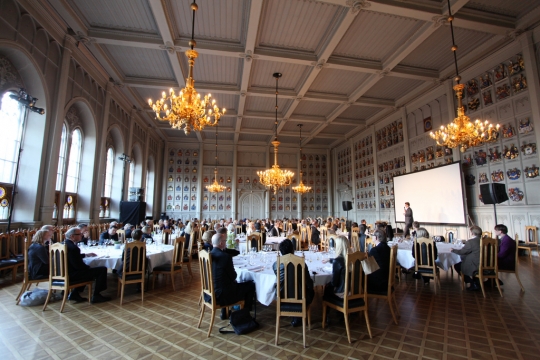
Mikko Kosonen, President of Sitra, welcoming everyone to Finland
As punctuation to the meal and the many conversations at every table, we added three pieces of programme. Over appetizers Filmmaker/Architect Helen Han premiered Tending The Garden City, a short film focusing on the Daily Dump which she created and we produced.
After the main course was cleared Tyler Brûlé, Editor-in-Chief of Monocle Magazine, hosted a conversation embodying the "government meets design" theme of HDL. Finland's Minister of Housing, Jan Vapaavuori and Chilean architect (and Studio member) Alejandro Aravena had a frank discussion about what they saw to gain from engaging each other's work.
To set the night off right, Helsinki-based architect Tuomas Toivonen took the stage for a lecture on architecture... set to music! Tuomas' "Architecture Is In The House" LP will be available for digital download in the near future and we highly recommend you check it out if you get a chance.
And a whole lot more over at Flickr!
All photos in this post are by Pekka Mustonen.
Editor's note: We offered this blog as a platform to four HDL Global participants who are documenting the event for everyone to get a glimpse of how things are going down. This is one such post from Helen Han.

Helen Han introducing her film, Tending The Garden City. Photo: Pekka Mustonen
Immediately arriving at the HDL conference I was taken aback by the historical space in which it was held. Hundreds of intricate crests lined the walls which provided not only an impressive backdrop but also an appropriate juxtaposition between legacy and the future, government and design. My short film was the first thing to kick off the start of the conference and despite a few technical glitches, it seemed to have been warmly received. If anything, for myself, it reiterated the accessibility of the medium and the imperativeness of both government and design to find a common ground for communication not only between each other but more importantly with the public.
This was most clearly defined through Eric Rodenbeck’s presentation that proved the ability of data visualization to act not just as an illustrative tool of what is already understood but as a method to raise more questions and generate unknown realizations. As the conference host and moderator, Marco Steinberg also poignantly brought to light other design skill sets that are applicable to understanding complex governmental systems. For instance, the designer’s trained ability to analyze data while shifting scales in the evaluation of site and data proved a necessary tool for governmental bodies, especially when there is a need to understand national, regional and local situations simultaneously. Overall, with my own background in architecture, it was refreshing to listen to the expansiveness of my training applied to a more meaningful institution, beyond the somewhat superficial confines of designing beautiful artifacts.
Expanding from this notion of design effectiveness and potential influence, the next days’ panel discussion on sustainability opened up a plethora of ideas concerning political, social and cultural agendas in designing the future environment. In a midst of somewhat argumentative yet productive discussions that exposed differences between national agendas, the one common ground that was found was an optimistic notion of laying down the foundation now that would influence the immediate and distant future through the implementation of education and design.
Out of the midst of an unclear future, the designer’s ability to offer a communicative tool that presents a multitude of questions (and understanding what those right questions are) is what seemed, at least to me, the brightest steps in understanding the hardships that tomorrow might bring and how we can prepare in order to brace ourselves for that unknown tomorrow.

